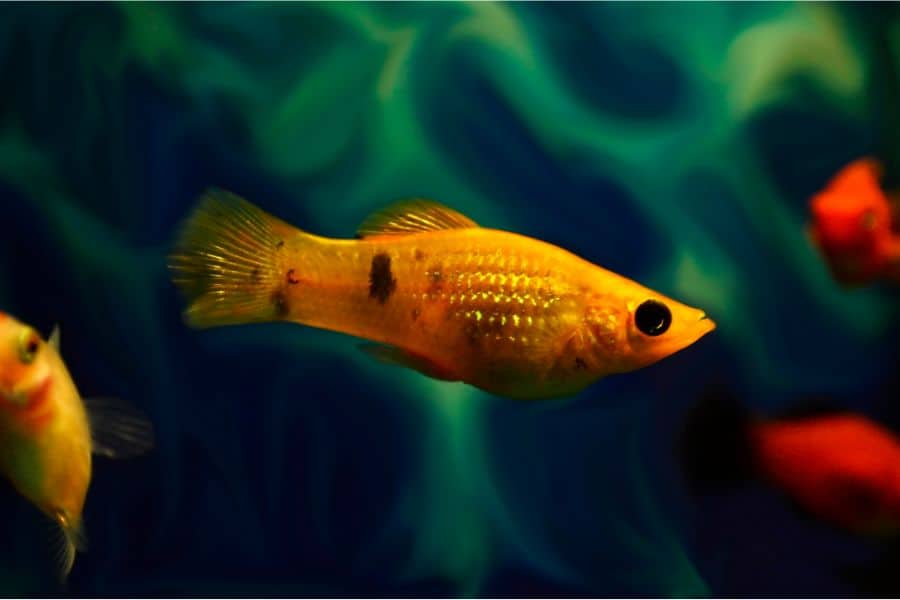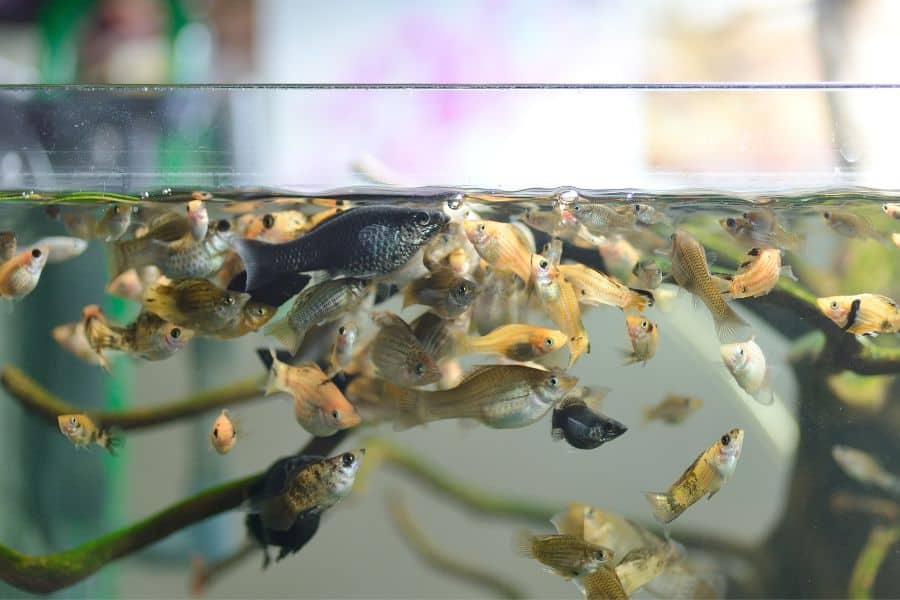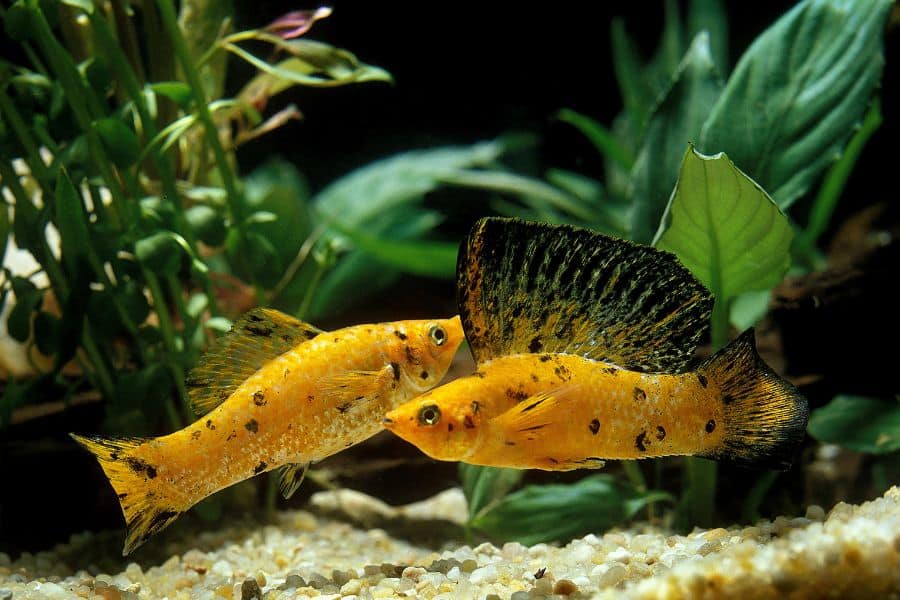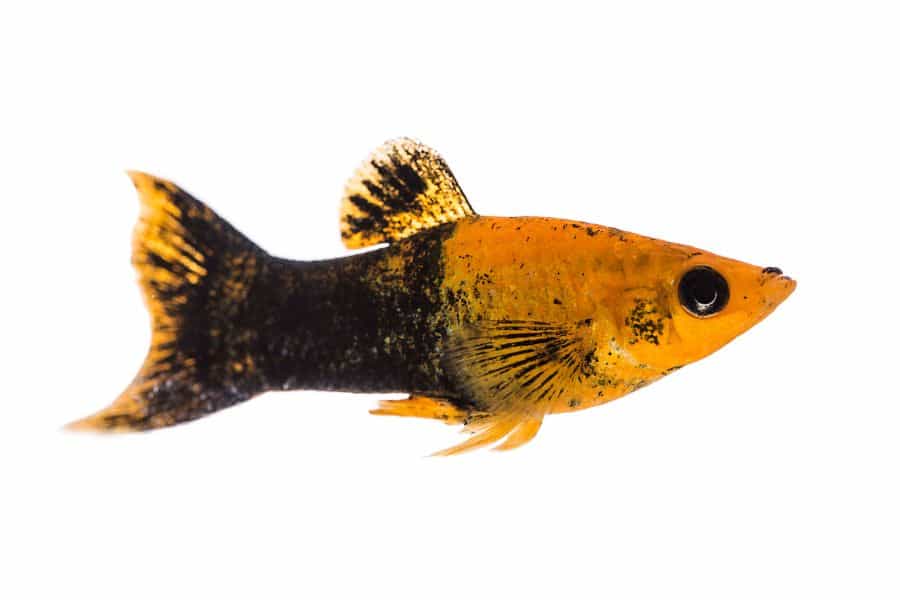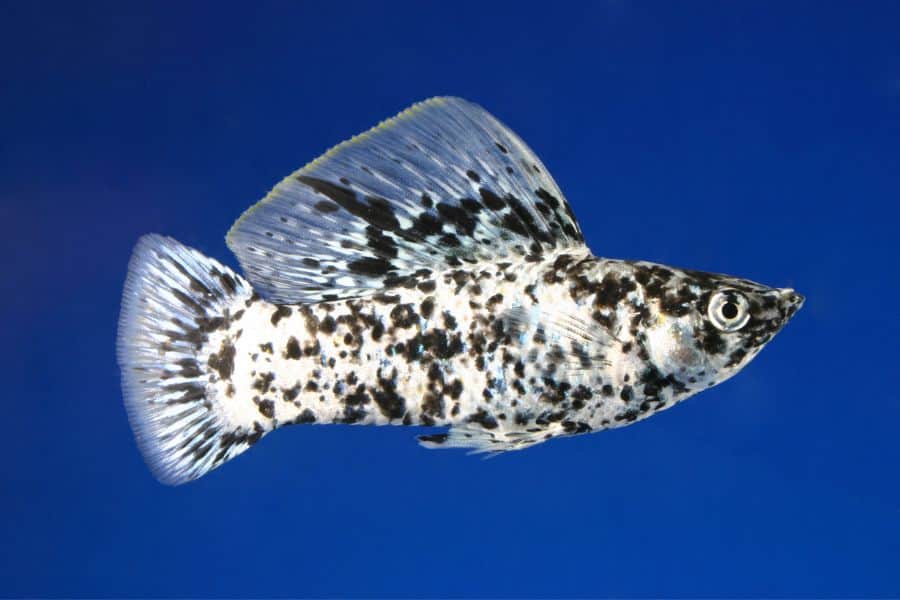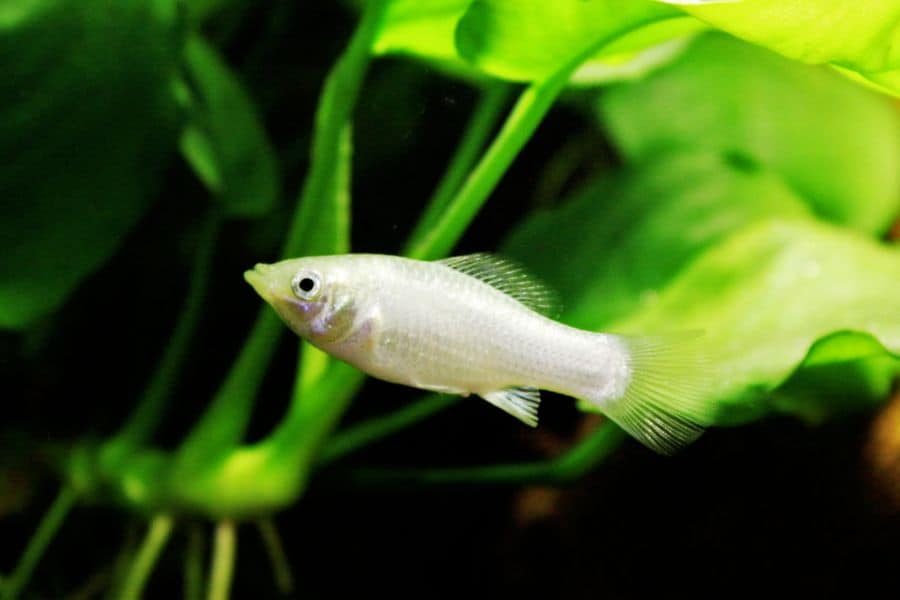Are you looking to add a Molly fish to your aquarium?
Molly fish are a popular choice among aquarium hobbyists because of their attractive coloration, patterns, and ease of care. They belong to the Poeciliidae family and are native to the shallow water of North and South America.
Most molly fish breeds can withstand a range of environments, making them suitable for aquariums. However, they are several types of mollies in the fish pet industry, each with its unique characteristics. Because of this, finding the right molly breed can prove overwhelming.
But worry not! This comprehensive guide will help you identify the most suitable Molly fish for your tank. Join us as we explore the various types of molly fish, including their appearance, care, and diseases.
Molly Fish Based on Appearance
Before we can dive into the various types of molly fish, let’s see how mollies vary in terms of their appearance. Molly fish can assume different appearances. Some can have long dorsal fins, with small round bodies, while others can have short fins, with long flattened bodies.
Several factors, including genetics, environmental conditions, gender, water quality and diet, can often influence the appearance of mollies.
Understanding molly fish appearance will help you identify and select a fish species that can enhance your aquarium aesthetics and overall experience.
On that note, molly fish appearance boils down to four aspects: Color, Fin Type, Tail Type, and Body Shape. Below, we have discussed these aspects.
Colors Variants
Mollies come in a variety of colors. Here is a list of the most common and rare shades displayed by mollies.
- Black: Black is a very common color in mollies. Some mollies develop a black tone due to a severe case of melanism. These mollies usually have a pure velvety black tone. However, some might have highlights of gold, silver, or orange on fins or tails, but they are quite rare.
- Black and Yellow: Mollies with this color variation usually display bright-yellow or gold coloration on one half of the body. The other half is usually covered with specs of black and yellow/gold. A good example of such mollies is the Gold Dust Molly Fish.
- Blue: At the time of writing this guide, proper blue molly fish don’t exist. Sure, molly fish breeding has produced several varieties with blue specs, fins, and tails. But nobody is yet to breed an entirely blue molly. Nevertheless, some molly fish have silver or light blue bodies with dark black or blue tails.
- Red: Some mollies have a bright red or orange color, like the Red Sunset Molly. But others feature a red body speckled with white or black patches.
- Yellow: Like black, yellow mollies are not uncommon. The mollies might have vibrant yellow bodies or a combination of yellow coloration with black or white (particularly on the underbelly) spots.
- White: White is another common color in mollies. Some molly fish come in completely white. However, some might feature reflective silver bodies.
- Orange and white: This is another unique color variation in mollies. Mollies with such coloration can display streaks of white and orange throughout their bodies. But some have orange bodies with white underbellies.
- Orange and Black: This color variation is common in Sailfin mollies. These molly fish often have orange heads and white bodies with specks of black and yellow. The fins and tails usually display white and black spots.
- Black and White: Mollies can also have white bodies with large or small black patches. Most times, they resemble the Dalmatian dog. Examples of such mollies include the Dalmatian molly and Dalmatian Lyretail molly.
Fin Type
Mollies fall into two groups, depending on the fin types.
- Short-finned mollies–mostly Poecilia sphenops–have a narrow and short dorsal fin. This applies to both male and female molies. Their dorsal fins also start behind the anal fin. A common example of short-finned molly is the Common black molly.
- Long-finned mollies or sail-fin molly fish comprise three groups: Poecilia petenensis, Poecilia vilifera, and Poecilia latipinna. The males of these species come with broad, high dorsal fins, which they use during mating and to scare off other males. The dorsal fin is located in front of the anal fin. A good example of such molly is the Giant Sailfin Molly.
Tail Type
As for tail type, molly fish usually have a fan-shaped tail featuring a range of colors or patterns. However, some mollies like Liberty molly have a more rounded tail. Other molly fish, like Golden Sailfin Molly, feature a pointed tail.
Body Shape
Short-finned mollies generally have a round and compact body, with a triangular-shaped head. But the males usually appear smaller and slimmer than females.
Most long-finned mollies come with elongated bodies, with a pointed head. Their bodies are also more streamlined compared to their short-finned counterparts. In addition, they have larger dorsal and caudal fins.
Selectively Bred or Hybrid Moll Fish
Yes, we said we will highlight four aspects. But this section will not be complete if we don’t discuss hybrid molly species.
Today, most molly fish are selectively bred to give rise to a variety of colors and patterns. For example, the Marbled molly fish is selectively bred to have several random black patches all over its body.
When the black coloration is arranged as streaks rather than specks, the molly is usually designated as a “harlequin”. The Harlequin Sailfin is a great example of hybrid molly with black streaks.
Besides coloration, some mollies have been selectively bred for body and fin shape. Such molly fish often feature a stouter body shape, with caudal fins shaped like a lyre ( elongated top and bottom ends).
Common examples of hybrid mollies include:
- Creamsicle Lyretail Molly
- Creamsicle Lyretail Balloon Molly
- Creamsicle Sailfin Molly
- Balloon Molly
- Dalmatian Lyretail Molly
- Marble Lyretail Molly
Common Types of Molly Fish
1. Gold Dust Molly
- Care level: Moderate
- Color: Yellow/Gold and Black
- Maximum size: 3 to 4 inches
- Minimum tank size: 20 gallons
- Water Parameters: Temperature; 74 to 82°F, pH; 6.0 to 8.0
The Gold Dust Molly (Poecilia sphenops) is a hardy fish that can thrive in both fresh and saltwater.
This aquarium fish stands out because of its distinct gold body color with black spots. They are also peaceful and never start a fight.
As a result, they can co-exist with other fish in a community tank. Just ensure you do not put them with aggressive fish like Bettas and Gouramis.
Gold Dust Mollies are omnivorous and prefer a diet of plant matter. However, you can provide them with protein-rich foods, like pellets, flakes, and frozen or live foods (such as blood shrimp and bloodworms.
2. Common Black Molly
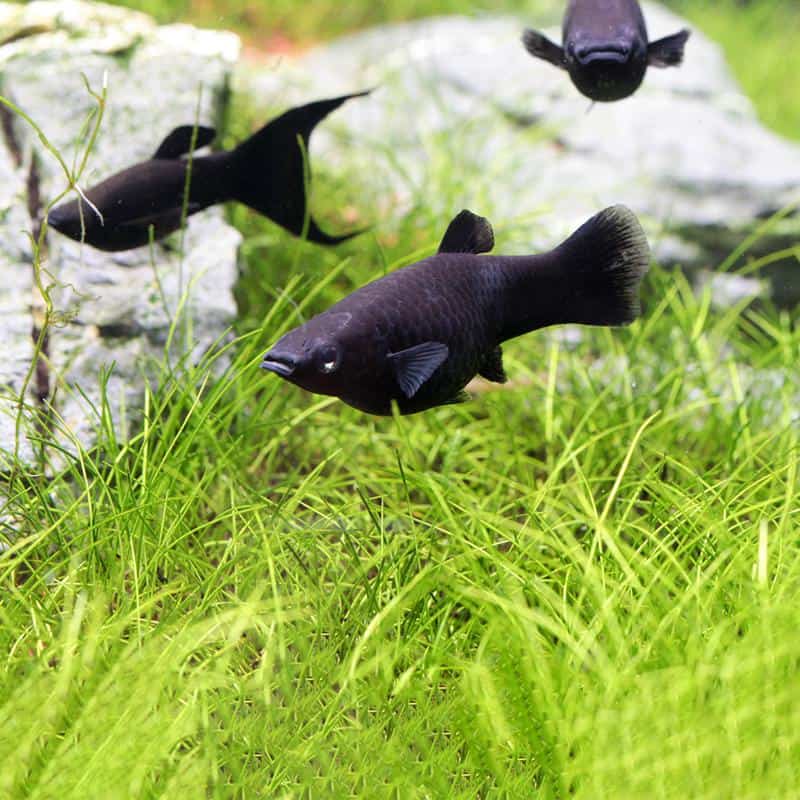
- Care level: Easy
- Color: Black and spots of orange or silver
- Maximum size: 3 to 4 Inches
- Minimum tank size: 30 gallons
- Water Parameters: Temperature; 68 to 72°F pH; 7.0 to 7.8
The Black Molly or Common Black Molly (Poecilla sphenops) is among the most popular and decorative freshwater fish. The dark color of its scales results from a serious case of melanism (increased amounts of dark pigment).
Most black mollies have a completely black tone, but some can feature orange, yellow, or silver streaks running down the dorsal fin or tail.
Native to the tropical rivers and streams of South and Central America, these molly fish prefer aquariums with carefully monitored waters. Since they are social fish, it’s best to keep them in groups of at least 3 or 4.
Also, add live plants (for the mollies to graze on) and plenty of hiding spots. They also require open swimming areas, shelter, and a light source.
3. Dalmatian Molly Fish
- Care level: Easy
- Color: White and Black
- Maximum size: 4 Inches
- Minimum tank size: 20 gallons
- Water Parameters: Temperature;75 to 82°F pH; 7.5 to 8.5
The Dalmatian Molly is an excellent pick for aquarium hobbyists. It’s a short-finned molly fish that is hardy and easy to care for.
Like the Dalmatian dog, these mollies feature a white body speckled with black spots. They can also grow up to 4 inches, so they require tanks larger than 20 gallons to live comfortably.
Dalmatian mollies are happiest in well-planted aquariums with lots of hiding spots and open spaces to swim. They are usually peaceful and exhibit no sign of aggression or territorial tendencies unless provoked.
As for diet, Dalmatian mollies need high-quality pellets and flakes. You should also provide them with some brine shrimps and blood worms.
On the downside, these fish are susceptible to shimmies–a disease that causes their body to rock from side to side. To prevent shimmies, monitor the water quality regularly to eliminate bacteria and toxins.
4. Liberty Molly
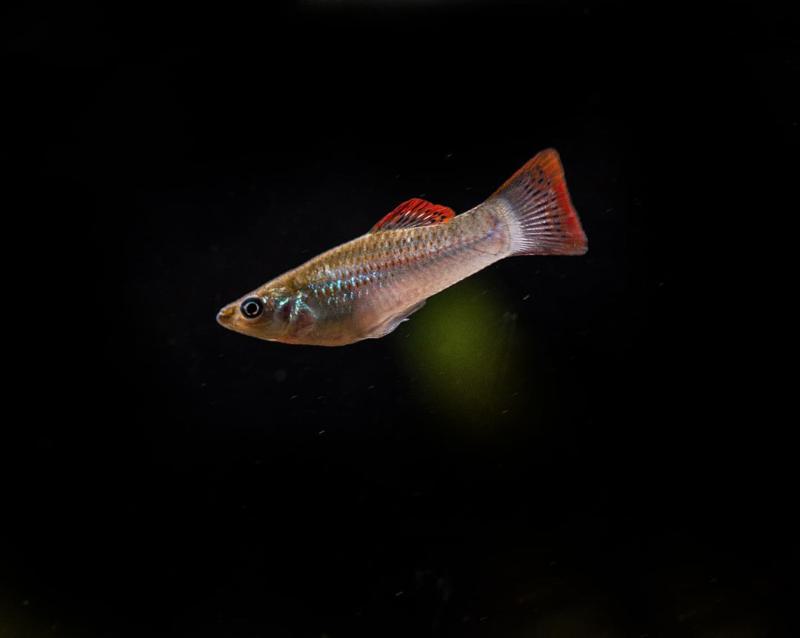
- Care Level: Moderate
- Color: Silver with a mix of yellow and blue or red
- Maximum Size: 3 to 4 Inches
- Minimum Tank Size: 30 gallons
- Water Parameter: Temperature; 75 to 82°F, pH; 7.5 to 8.0
The Liberty Molly (Poecilia salvatoris) is a short-finned molly species that originates from El Salvador.
These mollies come with a bright silver body spotted with blue and orange colors. Their fins and tails can have a mix of black and blue, plus red or yellow. Although males and females have the same coloration, males are more vibrant.
Liberty molies can be aggressive towards other tankmates, especially males. They often chase and nip other fishes in the aquarium. Therefore, it is best to keep liberty mollies in a species tank, in a ratio of two females to one male.
In addition, cover your tank with a lid because this fish is prone to jumping.
5. Dalmatian Lyretail Molly
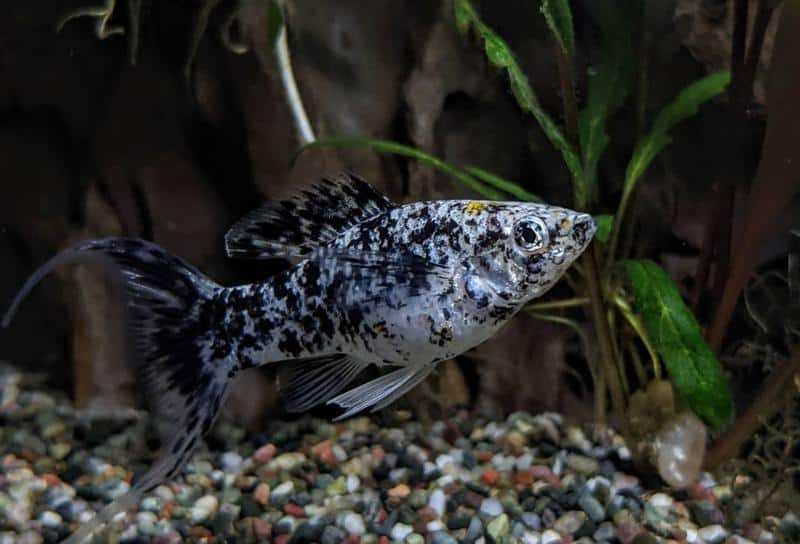
- Care level: Easy
- Color: Marbled White and Black
- Maximum size: 3 Inches
- Minimum tank size: 30 gallons
- Water Parameters: Temperature; 65 to 82°F, pH;7.0 to 7.8
The Dalmatian Lyretail molly is a selectively bred fish with a unique lyretail body and stunning marbled color. It’s a beginner-friendly fish species that can grow to a maximum size of 3 inches and live for 3 to 5 years.
While it shares the same tank setup as other mollies, it’s crucial to maintain the correct water parameters for the fish to thrive. Don’t forget to add some live plants and decorations like caves and driftwood.
Dalmatian Lyretail mollies have a small stature, red-tipped fins, and are whiter than the Dalmatian Molly. They are easy to care for and can survive in different environments. Although these fish are peaceful, they can show aggression when provoked.
6. Balloon Molly/Balloon Belly Molly
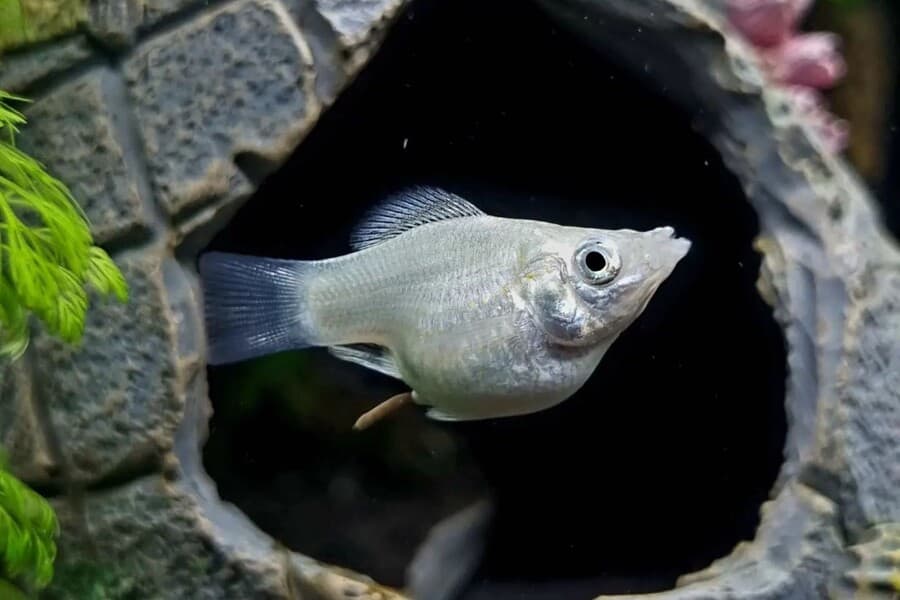
- Care level: Moderate
- Color: Various colors
- Maximum size: 3 Inches
- Minimum tank size: 20 to 30 gallons
- Water Parameters: Temperature; 68 to 82°F, pH;7.0 to 7.8
The Balloon Molly (Poecilia latipinna) is another highly sought aquarium fish because of its unique shape and color selection. The fish has a rounded belly and arched back and comes in a kaleidoscope of colors, including silver, white, orange, yellow, and black.
Balloon Molly fish are pretty straightforward to manage. They require a tank with at least 30 gallons of water and an excellent filtration system.
Although these fish prefer swimming in the mid-water area, a layer of sandy substrate and decorative pebbles will help provide the tank with a more natural look. Balloon mollies also require plenty of live plants they can nibble on and use to hide from predators.
Additionally, Balloon molly fish are social, schooling fish. That means aquarium enthusiasts should keep a group of at least 3 to 6 fish–with more females than males.
7. Platinum Lyretail Molly
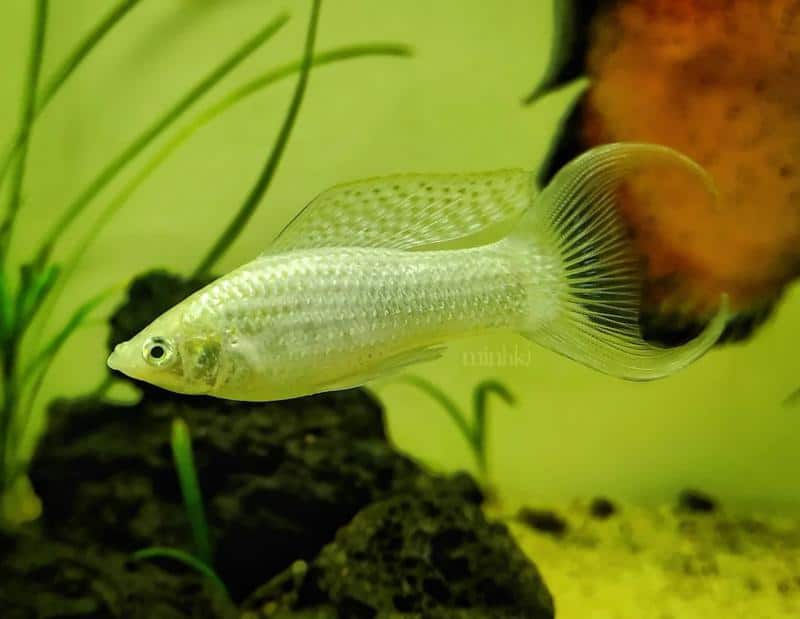
- Care level: Moderate
- Color: Platinum
- Maximum size: 5 Inches
- Minimum tank size: 30 gallons
- Water Parameters: Temperature; 75 to 82°F, pH;7.5 to 8.5
Another Molly fish that can make a great addition to an aquarium is the Platinum Lyretail Molly (Poecilia Velifera). It’s a super rare fish species because it’s hard to breed than other mollies.
Wild forms of this moly have green with dark specks on the dorsal fin. However, the most popular variants have pale pink bodies with purple fins and long metallic silver tailfins (with long edges).
However, the long tail fins will only develop if the fish live in tanks with plenty of open swimming spaces. Experts recommend keeping these fish in a 30-gallon tank with gravel substrate, plants, and plenty of hiding spots.
Also, it is essential to maintain the right water parameters in terms of temperature and pH levels. This will help prevent fungi and bacteria buildup that can lead to diseases like ich and shimmies.
8. Marble Lyretail Molly
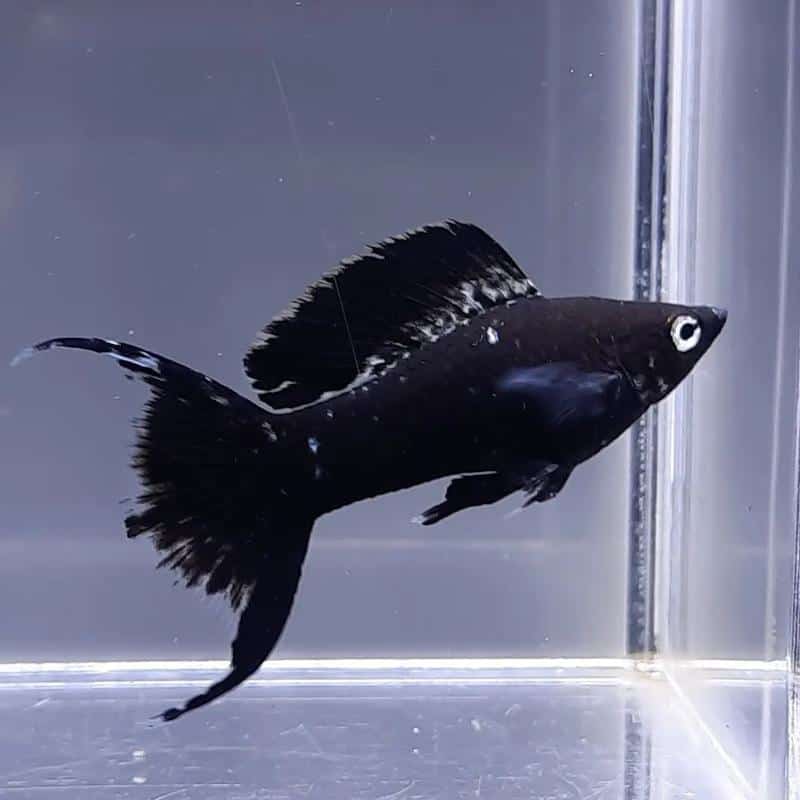
- Care level: Easy
- Color: Black and White
- Maximum size: 2 to 3 Inches
- Minimum tank size: 30 gallons
- Water Parameters: Temperature; 75 to 82°F, pH;6.5 to 7.5
If you are searching for a molly fish that will add color and activity to your tank, consider the Marble Lyretail Molly.
It’s a very hard fish species that can live in a wide range of environments. However, they prefer water with a slightly high salt content. As such, ideal tank mates should have some tolerance to salty water.
At first glance, you might confuse the Marble lyretail molly with Dalmatian Molly. But there are a few differences. First, they have a lyretail- the two filaments that give their long tail a moon-like shape. Second, their black spots appear darker and larger than those on Dalmatian Molly.
Marble Lyretails’ diet comprises mainly algae and small invertebrates in the wild. But in an aquarium, they can feed on high-quality flakes and pellets. They will also pick nuisance algae off decorations and rocks, keeping the tank clean.
9. White/Silver Molly
- Care Level: Easy
- Color: Silver with a mix of yellow and blue
- Maximum Size: 3 to 5 Inches
- Minimum Tank Size: 30 gallons
- Water Parameter: Temperature; 68 to 82°F, pH; 7.5 to 8.0
The white/silver molly fish is a hybrid of the common molly fish and is a great choice for novice aquarists. It has a silver body with beautiful long fins. As the name suggests, its primary color is silver/white. However, some mollies of the same species feature unique coloration on the fins and tails.
These peaceful mollies grow to an average of 4 inches, but females can reach 5 inches. They are social and will co-exist peacefully with other mates in a community tank. Males sometimes can display territorial and aggressive tendencies towards other males. But you can mitigate this situation by keeping more females than males.
Like most mollies, the white/silver molly fish is an omnivore and prefers a diet of live food, like bloodworms. But you can feed them with frozen food and high-quality pellets and flakes.
10. Black Sailfin Molly
- Care level: Easy
- Color: Black
- Maximum size: 5 Inches
- Minimum tank size: 30 gallons
- Water Parameters: Temperature; 75 to 82°F, pH;7.5 to 8.5
The Black Sailfin mollies (Poecilia latipinna) are among the most popular Sailfish Molly species. They look like the common Black Molly but have a much darker tone with long, flowing fins and rounded tails. Some have highlights of yellow, orange, or white on their fins and tails.
In the wild, Black Sailfins thrive in the coastal waters of the Gulf of Mexico and the Atlantic Ocean. And eat algae, tiny insects, and other small water creatures. In an aquarium, they require plant and protein-based feeds to stay healthy.
The Black Sailfin mollies are social creatures and should be kept in groups of 3 to 6. It’s wise to keep three females to one male to reduce aggression during molly fish breeding. Since Black Sailfins are peaceful, avoid keeping them with tank mates that might bite their long-flowing fins like tiger barbs.
11. Golden Sailfin Molly
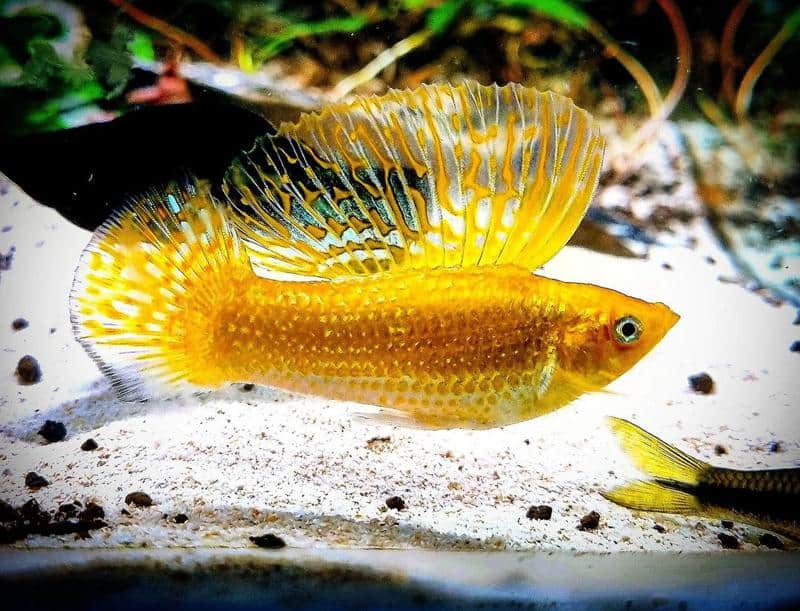
- Care level: Easy
- Color: Golden-yellow
- Maximum size: 6 Inches
- Minimum tank size: 30 gallons
- Water Parameters: Temperature; 68 to 82°F, pH;7.0 to 8.0
The Golden Sailfin Molly is an active and peaceful fish that loves brackish environments like swamps, streams, and coastal marshes. They have a stunning coloration of bright gold and beautiful flowing fins.
They are arguably one of the largest mollies since they can reach an impressive length of 6 inches when fully grown. For this reason, they require plenty of open swimming spaces to swim freely and grow to their maximum size. We recommend you get a 30 gallons tank if you plan to keep this fish.
Mollies are known to resist a variety of diseases. However, Golden Sailfins are susceptible to fungus, itch, and shimmies. Luckily, adding a teaspoon of aquarium salt can help prevent these conditions.
12. Red Sunset Molly
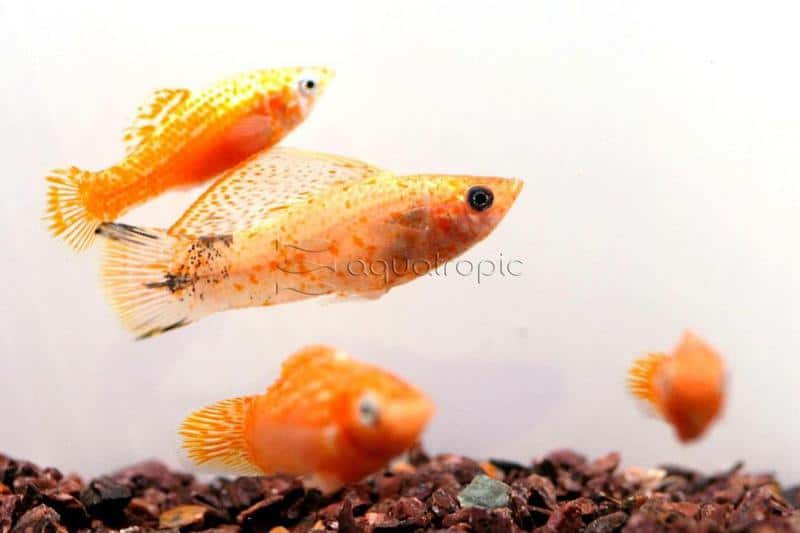
- Care Level: Easy
- Color: Red
- Maximum Size: 2 to 3 Inches
- Minimum Tank Size: 30 gallons
- Water Parameters: Temperature; 65 to 80° F, pH; 7.5 to 8.2
Red Sunset Mollies are attractive live-bearing fish, meaning the females release live fry.
This molly fish is closely related to the guppy fish and are both members of the genus, Poecilia. They are omnivorous and often prefer a diet of plant and animal matter. However, you can feed them with flakes, pellets, and frozen foods.
In addition, they prefer warm tanks with clean water. It will also help to add some plants, like dwarf lilies, to provide them with hiding and chilling spots. Don’t forget to keep more females that males. Otherwise, the male will harass the females in an attempt to mate, leading to stress in females.
13. Harlequin Sailfin Molly
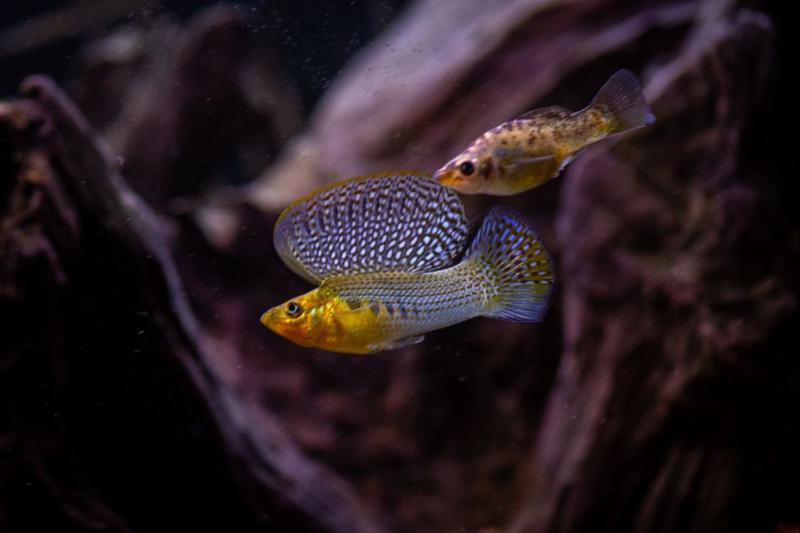
- Care level: Easy
- Color: Black, Gold and White
- Maximum size: 6 Inches
- Minimum tank size: 30 gallons
- Water Parameters: Temperature; 68 to 82°F, pH;7.0to 8.0
Speckled with white, black, and gold patches, the Harlequin Sailfin Molly is a hybrid variety of the Sailfin molly. Like the Golden Sailfin, these fish can grow up to 6 inches long and live for 5 years in captivity.
Besides their unique and dazzling coloration, they are peaceful, friendly, and active. As a result, they make a perfect addition to community tanks with tankmates of the same temperament.
In the wild, they live along marshes, ponds, swamps, and streams with plenty of rocks, plants, and aquatic organisms.
As such, they will only flourish in aquariums that mimic their natural habitat. They prefer tanks with many live plants and hiding spots around the bottom.
In addition, Harlequin Sailfins require a balanced diet of plant and animal-based foods, twice a day. Otherwise, they will graze on the live plants in the aquarium.
14. Green Sailfin Molly
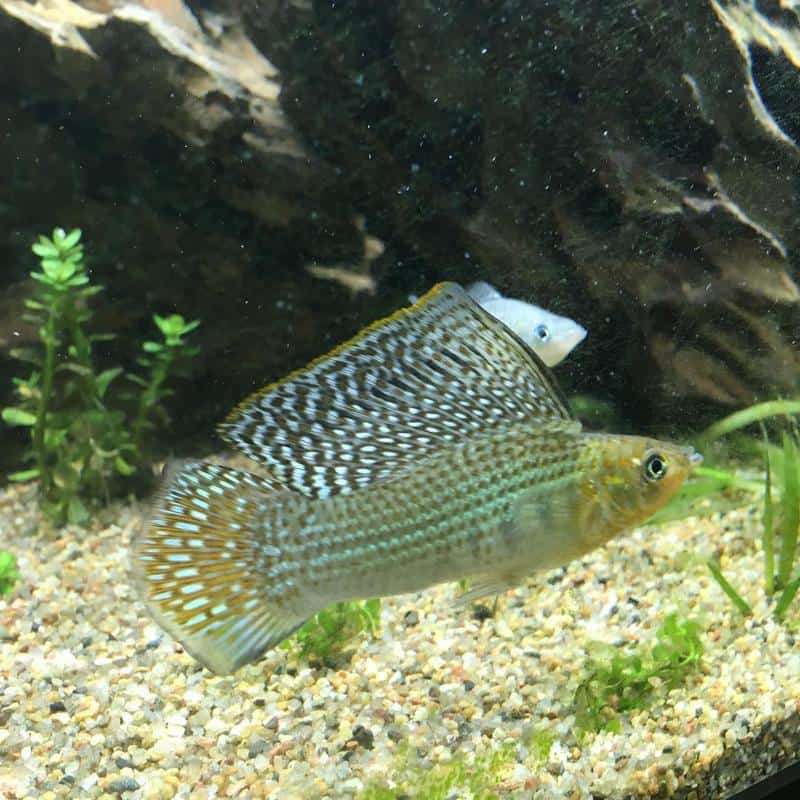
- Care level: Easy
- Color: Green speckled with white spots
- Maximum size:5 Inches
- Minimum tank size: 30 gallons
- Water Parameters: Temperature; 68 to 82°F, pH;7.0to 8.0
The Green Sailfin Molly is another hybrid fish species developed from the cross three will Sailfin mollies: Poecilia velifera, Poecilia petenensis, and Poecilia latipinna.
These mollies have a distinct reflective green-blue coloration with white spots on the fins and tail. They are peaceful and friendly and do best in a group of a few males and several females.
Green Sailfins also make excellent tankmates when placed with fish of similar temperaments like Swordtails, Angel Fish, Corydoras, and Plecostomus.
As an aquarium fish, Green Sailfins can feed on flakes, pellets, and frozen foods. But they also love live foods like brine shrimps, mosquito larvae, bloodworms, and other invertebrates.
15. Creamsicle Sailfin Lyretail Molly
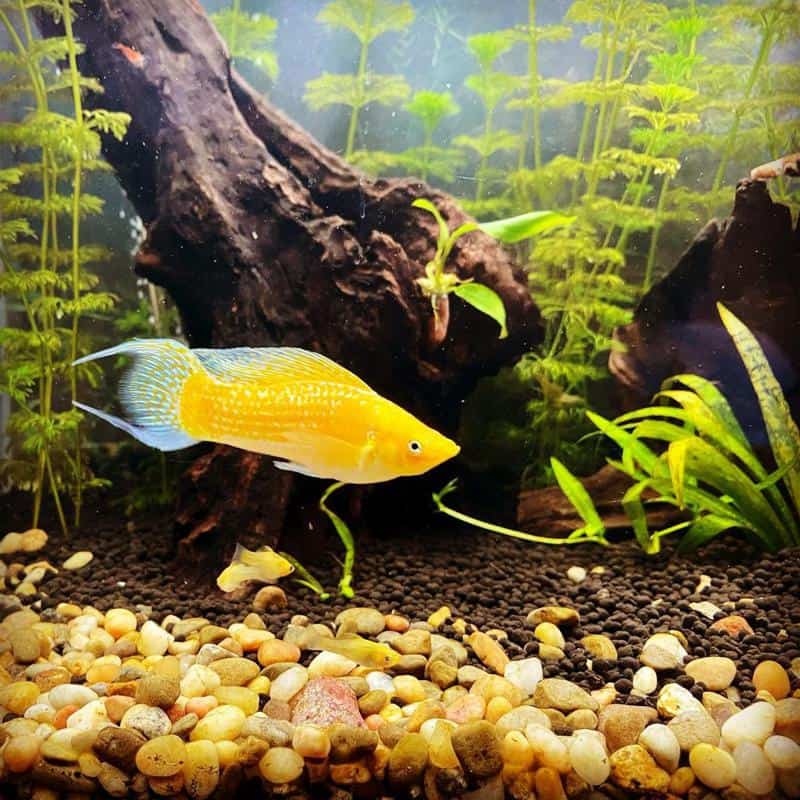
- Care level: Easy
- Color: Orange and White
- Maximum size: 3 Inches
- Minimum tank size: 20 gallons
- Water Parameters: Temperature; 72 to 82°F, pH;7.0 to 7.8
The Creamsicle Sailfin Lyretail molly is a small fish species that grows up to 3 inches. It gets its name from its light-orange and white coloration, which resembles a creamsicle ice cream. The unique coloration also extends to the fins and tails, but as specks.
This molly fish breed is ideal for beginners since it is easy to for, looks attractive, and can tolerate a wide range of pH and water temperatures. Furthermore, it consumes a selection of foods, including vegetables, raw meats, flakes, etc.
16. Yucatan Molly Fish
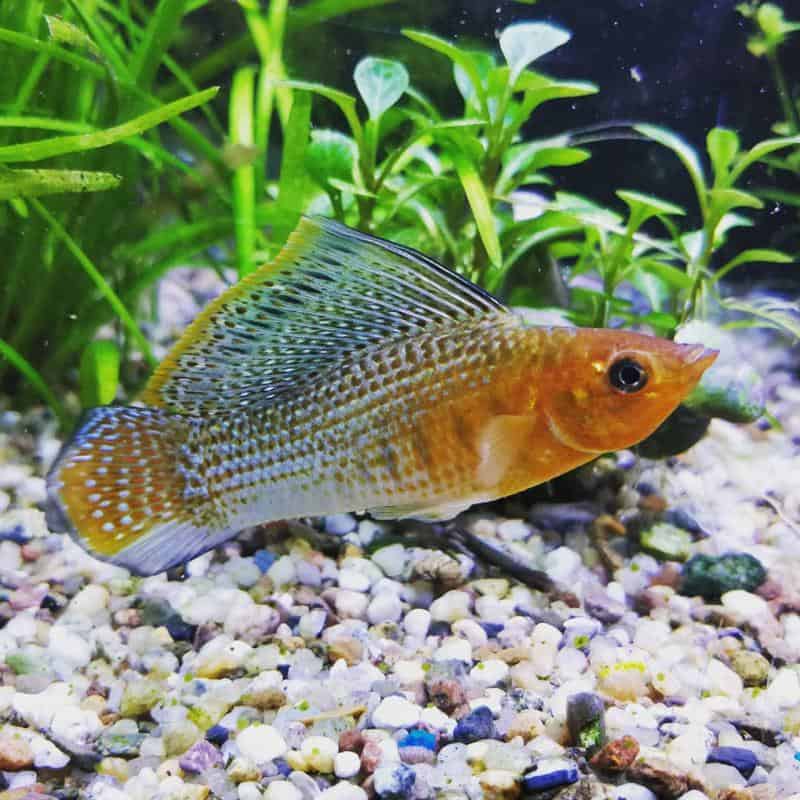
- Care level: Easy
- Color: Various bright colors
- Maximum size: 5 to 8Inches
- Minimum tank size: 40 gallons
- Water Parameters: Temperature; 77 to 83°F, pH;7.0 to 8.0
The Yucatan fish is among the most popular natural molly breed. Even though it looks like the Sailfin molly, it grows longer and larger, with females reaching 8 inches. Yucatan molies also have bigger dorsal fins than other mollies.
These mollies come in silver and gray or tan coloration. But captive-bred Yucatan fish can feature a variety of bright colors. They prefer warmer environments and good water quality. Because of this, it’s extremely important to monitor and regulate water parameters frequently.
Yucatan mollies are active and will add activity to your tank. However, they might chase and bully smaller fish, especially during mating season.
Also Read:
- Platy and Molly: Similarities and Differences
- How Long Do Mollies Live?
- Most Common Gourami Fish Types
- Types of Guppies
Conclusion
Mollies make great aquarium fish for beginners and experienced aquarists. They have low-maintenance care requirements and are hardy. Besides that, they come in a variety of colors, have fascinating behaviors, and keep the tank clean.
These 16 types of Molly fish stand out for their striking appearance and unique features. But don’t limit yourself to this list alone. Research other Molly fish varieties that we might have missed.
If you have found our guide helpful, please share it with your friends. And if you have any questions, leave us a comment below.
